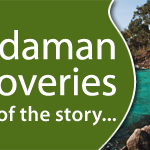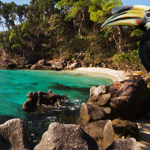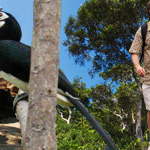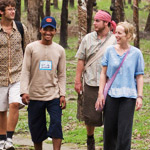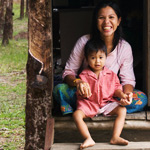Andaman Discoveries Blog
Tuesday, June 30, 2009
Rebecca’s Journal – Meeting Gary the Gecko
 |
| Rebecca’s roommate, “Gary the Gecko.” |
The power was out on the entire street when I arrived home after the first day of volunteer orientation. My phone made a useful light, so I could make my way to the bathroom.
I shined my phone around the room. My heart stopped. On the wall next to me was a massive (well, maybe I’m exaggerating a little) gecko staring right at me!
There have been few times in my life that I have moved as quickly, as I did that moment. I made a mad dash to the bedroom.
The bathroom seemed too close for comfort, so I put a fan in front of the door just in case the gecko chose to follow me. It took about an hour for me to muster the courage to leave the bedroom. I nervously opened the door, shining the phone light around to check that the gecko wasn’t lurking close by. After a close inspection, I decided the coast was clear.
I relayed the gecko encounter to the AD team. They found it rather amusing. It was explained that geckos inhabit most Thai homes. The geckos eat the flies, mosquitoes and spiders in your house. I was told that they’re not harmful and are actually seen as lucky.
After much deliberating, I decided a gecko was certainly better than flies, mosquitoes and spiders. The best option was to befriend my gecko and keep him on my side.
That night I went home ready to give the gecko a second chance. The power was back on, allowing me to get a better look at my new friend. Upon closer inspection, I saw he was surprisingly cute (ish).
I named the gecko, Gary. While I still shut the bedroom door at night, I quite enjoyed having Gary around. Once Gary and I were used to each other, a beautiful friendship was formed.
Saturday, June 27, 2009
Rebecca's Journal - First Day in Thailand
My journey to Thailand was less than successful: sleep was merely a dream, the flight was exorbitantly long and then came the ill-fated misplaced luggage. I quickly began to wonder if leaving England for Thailand was such a bright idea after all.
As I made the trip from Phuket to Kuraburi, I felt a smorgasbord of emotions. Nervousness and curiosity consumed me as I was unsure of what lay ahead.
I arrived at the Andaman office tired and dazed. Kelly, Karen and Leslie greeted me, offering a warm welcome. I felt at ease and my nerves subsided immediately.
 |
| Kelly May describes the different Thai dishes to Rebecca at a team dinner. |
They took me to see the house that would be home for the next month. My first reaction was a tinge of shock. Thai houses are different from those in England. For starters, it came with geckos, but more on that later. I loved that my house was pink, but was unsure how enjoyable cold showers would be.
Once I was settled into the pink house, the team invited me to experience my first lunch in Thailand. We traveled to a restaurant about five minutes from Kuraburi for the traditional Thai meal, Som Tam, a salad made from un-ripened papaya. I was impressed even though the meal had more spice than my England taste buds were used to.
I couldn’t have been happier to go to bed at the close of the first day in Thailand. My initial feelings of nervousness were replaced with excitement for the next day ahead.
Labels: Kuraburi, Thai food, volunteer
Friday, June 26, 2009
A different kind of guide book: Travelers’ Tales Thailand
Experiences in Thailand
By Leslie Welshimer
Traveling to unfamiliar places can be daunting or delightful. Getting answers to important questions in advance increases the odds that one won’t miss out on amazing experiences or unknowingly offend someone.
 Before visiting a new place, I’ve found it to be immensely helpful to read and study up on topics like the culture, geography, local holidays and weather. Otherwise, you may travel six hours to visit a place, like the Surin Islands, only to learn it’s closed for the rainy season.
Before visiting a new place, I’ve found it to be immensely helpful to read and study up on topics like the culture, geography, local holidays and weather. Otherwise, you may travel six hours to visit a place, like the Surin Islands, only to learn it’s closed for the rainy season.I came to Thailand in February 2009. In an effort to minimize my footprint on the Thai culture, I was determined to gain as much of an understanding as possible of Thailand. My goal was to arm myself with an arsenal of literature to educate myself before departure and along the way. I made a pact to only read books related to Thailand while in the country.
 When I departed Seattle, my luggage contained four books:
When I departed Seattle, my luggage contained four books:- A History of Thailand by Chris Baker and Pasuk Phongpaichit
- Buddhism for Beginners by Thubten Chodron
- Lonely Planet Thailand guidebook
There was a fifth book I wanted before departure, but I was unable to secure it. Luck was in my favor because in March, the Hoyt family visited Andaman Discoveries. The family came with the book, Travelers’ Tales Thailand, edited by James O'Reilly and Larry Habegger. The Hoyts were finished reading the book and asked if anyone would like it. I raised my hand like an anxious grade school kid at a chance for a cupcake.
Travelers’ Tales Thailand is a Lowell Thomas Award Winner - Best Travel Book. It is a series of short stories or excerpts from complete books by highly regarded authors like Pico Iyer, Diane Summers and Jeff Greenwald.
I finished Travelers’ Tales Thailand in May. It provided an overview of Thailand with entertaining personal stories. The book reminded me a bit of the Chicken Soup for the Soul Series, but targeted at travelers.
It made the perfect book, as I could pick it up and read one story or more if I wanted. My only regret is that I didn’t read it before I departed Seattle. It contained enlightening tidbits about the essence of Thailand that would have helped shape my expectations beforehand.
Travelers' Tales has more than 100 titles in print. I plan to make it a tradition to see if there is a Travelers’ Tales book available on future travels.
What’s next on my Thailand-immersion reading list? Kelly May loaned me her copies of, Culture Shock: Thailand (Culture Shock! A Survival Guide to Customs & Etiquette) by Robert Cooper and Nanthapa Cooper, and Letters from Thailand, by Botan and translated by Susan Fulop Kepner.
What is your favorite Thailand-related book? If there is a book that you recommend for Thailand travelers, please feel free to comment on the blog or contact us to share your thoughts.
Labels: Kelly May, Thai culture, Thailand
Wednesday, June 24, 2009
Rebecca's Journal - Introduction
Burmese Learning Center Welcomes English Teachers
We were fortunate to have Rebecca (UK) with us from mid-May to mid-June. She came to us through our partner organization, Twin UK, to teach English at the Burmese Learning Center.
 |
| Jeannine (volunteer English teacher), Kelly, Karen, and Rebecca at the Burmese Learning Center. |
Rebecca wrote about her experiences as a first-time teacher, being a newbie in Kuraburi and meeting her roommate, "Gary the Gecko."
“In the brief month that I taught at the Burmese Learning Center, I felt that I developed relationships with the students and teachers. The students' confidence and skills grew steadily, as did mine, as I learned to find my footing as a teacher in Thailand,” said Rebecca.
Her stories will be shared on the blog in the upcoming weeks, so check back soon.
Teaching at the Burmese Learning Center is one of several long-term volunteering programs offered by Andaman Discoveries. We can also arrange placements at the Phuket Disabled School or a Southern Thailand Orphanage.
Labels: Burmese Learning Center, education, Kuraburi, teaching english, volunteer
Tuesday, June 16, 2009
Kelly’s Journal
Creating Lifetime Humanitarians
 I returned to the energy of Andaman Discoveries after a seven-month absence, eager to resume the role of translator and guide. My first assignment was to help a group of YouthLINC volunteers, varying in age from 17 to over 80, organize in-village workshops.
I returned to the energy of Andaman Discoveries after a seven-month absence, eager to resume the role of translator and guide. My first assignment was to help a group of YouthLINC volunteers, varying in age from 17 to over 80, organize in-village workshops.In Ban Talae Nok, we conducted a health fair and first aid training with more than 40 villagers. Led by YouthLINC members, the events provided information on dental care, hygiene issues, family planning, and emergency medical care.
A personal highlight for me was translating during a cross-cultural ladies chatting session. After a delicious dinner, our time with the homestay ladies turned into an enlightening and amusing conversation – I’m glad the men weren’t present!
YouthLINC, a U.S.-based organization, aspires to create lifetime humanitarians through a strategic Service Year program, and participants contribute through community service projects in the U.S. and abroad.
Villagers recognized the value of the education shared, stating, “As homestay host families, it’s important we know basic first aid. Everyone should know what to do in an emergency.”
Megan Dennehy, a YouthLINC participant, said, “My visit to BTN was simply inspiring. I learned so much about the wonderful people and their lovely culture. I came with the intention of teaching the villagers and left being the one who had been taught by the villagers. They are beautiful people with the most tender hearts. I can’t wait to come back!”
Heather Bagley, a YouthLINC participant, said, “The village was an excellent opportunity to show the cultural differences of the Thai/Muslim people and Americans. Everyone in this village was kind, generous and very flexible. I wouldn’t change a thing about the homestay experience. I was completely comfortable and happy. Thanks for a fantastic adventure!”
Thank you to all the YouthLINC volunteers for your dedication and effort, in the United States and in Thailand. I hope to work with you again on your next journey.
Best Wishes,
Miss Kelly May
Labels: Ban Talae Nok, cross-cultural, humanitarians, Kelly May, service projects, YouthLINC
Erik’s Adventures - Fragile Footing
Can Ecotourism Save the Ban Naa River?
 P’ Lek stares wistfully at the banks of the Ban Naa River, located about 65 kilometers south of Ranong, while he pilots our inflatable raft downstream. On our left is a large concrete tower -- formerly part of a suspension footbridge -- now toppled and half-submerged, enmeshed in a tangle of cables. The surrounding land has all been cleared, stripping its rebar-like root system; recent monsoon rains swept away the tower’s vulnerable footing. Across the river a lone tower stands sentinel amongst dense forest.
P’ Lek stares wistfully at the banks of the Ban Naa River, located about 65 kilometers south of Ranong, while he pilots our inflatable raft downstream. On our left is a large concrete tower -- formerly part of a suspension footbridge -- now toppled and half-submerged, enmeshed in a tangle of cables. The surrounding land has all been cleared, stripping its rebar-like root system; recent monsoon rains swept away the tower’s vulnerable footing. Across the river a lone tower stands sentinel amongst dense forest.Further downstream we anchor at an oxbow where rubber tree saplings cling dearly to the abrupt precipice; this year alone the river’s dimensions at this location have swelled by several meters through erosion. Lek and his team of five villagers set about measuring the damage -- river width and depth -- using rope, a plumb, a tape measure, a length of blue PVC pipe, and a camera. I’m one of several Westerners who have joined them on this rainy day -- including staff from Andaman Discoveries, N-ACT, and the Peace Corps -- to survey roughly three kilometers of the Ban Naa River and assess its eco-tourism potential.
 A few years ago this muddy, silted beach was lined with a protective canopy of native jungle, with an accompanying chorus of high-pitched locusts and birdsong. And as many years ago the mono-crop plantations of rubber and oil palm that now conspicuously abut upon the river were home to varied fruit orchards. A recent drop in fruit prices encouraged the switch from these crops. “I love this area and want to see it restored. I am hoping to use tourism as a tool to re-introduce sustainable agriculture to the area,” Lek told us.
A few years ago this muddy, silted beach was lined with a protective canopy of native jungle, with an accompanying chorus of high-pitched locusts and birdsong. And as many years ago the mono-crop plantations of rubber and oil palm that now conspicuously abut upon the river were home to varied fruit orchards. A recent drop in fruit prices encouraged the switch from these crops. “I love this area and want to see it restored. I am hoping to use tourism as a tool to re-introduce sustainable agriculture to the area,” Lek told us.The nickname Lek, which is the Thai word for small, is as incongruous on this imposing forty-something man with a wispy ponytail as his 4X4 racing t-shirt is to his ethos of conservation. His vision is to staunch the degradation of this area and eventually reverse it by reintroducing the cultivation of sustainable mixed agriculture through community-based ecotourism. With tourists paying to harvest fruit, he hopes to make this type of farming financially viable again. In addition, he’s launching youth conservation efforts to educate young people as to the value of conservation.
 At the next stop Lek harvests a few krai nam saplings. These trees have robust root structures, and Lek will re-plant them upstream in areas where the shoreline has been compromised by erosion. By relocating them upstream he also hopes that their seeds will eventually find purchase in soil further down. Such ideas are in stark contrast to the solutions employed by the mono-crop farmers, as I soon learned firsthand. At another stop, we anchor the raft along a desolate shore of dirt and stones. I jumped out of the raft and thought ground had been pulled out from under me – here the river had been dredged with a backhoe, forming a deep channel right up to the shore. This practice requires continual maintenance, and drastically increases silting problems downstream.
At the next stop Lek harvests a few krai nam saplings. These trees have robust root structures, and Lek will re-plant them upstream in areas where the shoreline has been compromised by erosion. By relocating them upstream he also hopes that their seeds will eventually find purchase in soil further down. Such ideas are in stark contrast to the solutions employed by the mono-crop farmers, as I soon learned firsthand. At another stop, we anchor the raft along a desolate shore of dirt and stones. I jumped out of the raft and thought ground had been pulled out from under me – here the river had been dredged with a backhoe, forming a deep channel right up to the shore. This practice requires continual maintenance, and drastically increases silting problems downstream.To be sure, Lek and his team face an uphill battle. There are powerful, well-financed forces at work in the area whose only concern is quick profits. But the optimism of Lek and his staff is contagious, and combined with the natural beauty of the area one cannot help but feel inspired by his team’s grassroots efforts.
In addition to the rafting trip, the area offers attractive ecotourism opportunities such as a short hike to a hot/cold spring and an overnight hike to the La Ong Dao waterfall. The village of Ban Naa also offers visitors the opportunity to engage with the monks of a forest temple and the chance to learn from local artisans whose handicrafts include weaving and making rattan furniture.
For more information about Ban Naa, please contact Nat at info@andamancommunitytourism.com
Labels: agriculture, conservation, ecotourism, erosion, mono crop, rafting, sustainability
In the Spotlight
National Geographic recommends Andaman Discoveries
 The third edition of the award-winning “National Geographic Traveler: Thailand” hit bookshelves recently, and the current version recommends Andaman Discoveries for responsible tourism in Thailand. Guidebooks are an important way of sharing information with travelers, and we are grateful for another opportunity to shine light on responsible tourism.
The third edition of the award-winning “National Geographic Traveler: Thailand” hit bookshelves recently, and the current version recommends Andaman Discoveries for responsible tourism in Thailand. Guidebooks are an important way of sharing information with travelers, and we are grateful for another opportunity to shine light on responsible tourism.In addition to the National Geographic guidebook, Andaman Discoveries is featured in the Rough Guide, Lonely Planet, Natural Guide, and Beach Huts in Thailand (Denmark). We're also part of the responsibletravel.com network, as well as the Conservation International Community-Based Tourism Program, which supports and promotes community-based tourism ventures that offer significant conservation and development benefits to local communities.
Labels: Andaman Discoveries, guidebook, National Geographic, responsible tourism, Thailand
Drafting the Next Chapter
Team Andaman Looks Inward and Onward
 An unexamined life is not worth living, said Socrates more than two millennia ago, and, like life itself, the complexities of community development and conservation also require an introspective spirit. With that in mind, Andaman Discoveries dedicated the entire last weekend of May to a working staff retreat.
An unexamined life is not worth living, said Socrates more than two millennia ago, and, like life itself, the complexities of community development and conservation also require an introspective spirit. With that in mind, Andaman Discoveries dedicated the entire last weekend of May to a working staff retreat.Teamwork was the common goal, from the opening icebreaker in which everyone bunched together in a circle, then bent down and attempted to walk as one, to a finale of “Twister!” For the two days in-between the team worked as one, reviewing the Andaman Discoveries’ mission statement, organizational chart, and everyone’s individual contributions, with fresh feedback and ideas. The retreat was intense at times, as everyone delved deep into planning and direction. But with expert facilitation from seasoned veteran and friend Bill Tuffin, a firm team commitment, and a common vision of future viability, amorphous ideas crystallized into firm plans and clearer roles.
 The retreat was held in Khao Sok National Park at Our Jungle House, which is nestled amongst 25 acres of idyllic lush rainforest bordering the Sok River and soaring limestone cliffs. This was the natural choice for the retreat due to its peaceful setting, open working space, environmental philosophy, and proximity to Kuraburi.
The retreat was held in Khao Sok National Park at Our Jungle House, which is nestled amongst 25 acres of idyllic lush rainforest bordering the Sok River and soaring limestone cliffs. This was the natural choice for the retreat due to its peaceful setting, open working space, environmental philosophy, and proximity to Kuraburi.As anyone familiar with Andaman Discoveries knows, we work hard and play even harder, and by late Saturday afternoon serious fun was in order! The team hopped on inner tubes and plunged into the Sok River for a long, relaxing ride. The day’s intensity quickly dissolved in the crystal-clear mountain water. “It was stunning to be floating down a river in an inner tube with the rising moon and limestone cliffs looming above” said Leslie Welshimer.
Those with an insatiable appetite for adventure indulged in an encore trip, and were treated to perhaps the highlight of the weekend. At one point a bamboo shoot cantilevered over the river, on which a family of monkeys was foraging. We silently glided underneath just as the baby leapt through the air onto its mother’s back. Papa meanwhile dangled from the pole while fixing the spellbound tubers with a cautious simian gaze. The poignant encounter with nature was a reminder of why responsible tourism is important, and was one of those magical moments in Thailand that force one to pause and wonder, Is this a dream?
Labels: conservation, jungle, Khao Sok, monkey, Thailand
Turtle Hurdle Controversy
Naucrates Shares Insights
 We believe in maintaining an open dialogue with all of our partners. Naucrates has been our partner organization since the tsunami, and responded to a story in our April newsletter about releasing a baby sea turtle in Phuket. Turtle release events may vary drastically from one to another. The best bet is check with a reputable organization like Naucrates, who have a program to sponsor baby turtles and help this critically endangered species.
We believe in maintaining an open dialogue with all of our partners. Naucrates has been our partner organization since the tsunami, and responded to a story in our April newsletter about releasing a baby sea turtle in Phuket. Turtle release events may vary drastically from one to another. The best bet is check with a reputable organization like Naucrates, who have a program to sponsor baby turtles and help this critically endangered species.Dear Andaman Discoveries,
We receive your monthly newsletter and we are always impressed by the work that you are doing in Thailand. Reading the April newsletter, however, I felt sorry to read the article about turtles. The turtle releasing ceremony is very popular, and they are a great event to raise awareness but they are NOT a conservation tool!I am sure the person who had the opportunity to release the young turtle has not realized how hard it was for a green turtle hatchling (not leatherback as it is stated in the article) to be kept in the sun all day in the middle of thousands of people, at risk of dehydration...sea turtles are not social animals. There have even been cases of onlookers taking one of the baby turtles home.
Usually the turtles released are from Similan island, the only stable breeding population left in the Andaman sea). Turtles are known to go back and lay eggs on the same beach where they are born.... yet these babies are released on a totally different beach on a developed island.
I could continue, but the list would be too long... My opinion comes after years of working to save turtles swimming in the wild.....
Thank you for reading it,
Monica
Labels: endangered species, green turtle, Naucrates, sea turtle
Getting Branded
Potter Logo Design Captures the Andaman Discoveries Story
 Andaman Discoveries proudly unveiled our beautiful new logo last week. Congratulations and many thanks to Michaela Potter, co-founder of Briefcase to Backpack and owner of Wanderlust Productions. Michaela’s passion for travel inspires her creative side, and she gained firsthand knowledge of the Andaman Discoveries story during a four-day, three-night cultural tour in 2007.
Andaman Discoveries proudly unveiled our beautiful new logo last week. Congratulations and many thanks to Michaela Potter, co-founder of Briefcase to Backpack and owner of Wanderlust Productions. Michaela’s passion for travel inspires her creative side, and she gained firsthand knowledge of the Andaman Discoveries story during a four-day, three-night cultural tour in 2007.After considering many outstanding submissions to our call for a logo design, we concluded Michaela’s design best represents the story of Andaman Discoveries. Her simple and elegant design is symbolic of our mission and history on several levels. The Andaman Discoveries’ story began after the tsunami in 2004 and continues to this day. We continue to invite people to become a part of our ongoing story, in contributing to the sustainability of communities in the North Andaman Region in Thailand.
Labels: Andaman Discoveries, Briefcase to Backpack, logo, Michaela Potter, Wanderlust Productions
Andaman Discoveries at the United Nations
Lessons from the Andaman Coast Shared with International Commission
 As you may recall, AD won the prestigious 2008 SEED award. As part of the honors that come with the award, our work was recently highlighted at the United Nations Commission for Sustainable Development (UNCSD) in New York. So, we sent Mimi Cheung , our product manager and all around great gal, on a mission to the Big Apple!
As you may recall, AD won the prestigious 2008 SEED award. As part of the honors that come with the award, our work was recently highlighted at the United Nations Commission for Sustainable Development (UNCSD) in New York. So, we sent Mimi Cheung , our product manager and all around great gal, on a mission to the Big Apple!
After the event, Mimi said, “Winning the SEED Award lends credence to AD’s philosophy and work in Thailand. Many people were essential in the success we’ve achieved thus far. The lessons learned in New York will surely be a part of AD’s tomorrow.”
At the event, Mimi shared her knowledge with high-profile champions of sustainability including Thailand’s Minister for the Environment, the Minister of Agriculture from the Netherlands, and the Director General of IUCN.
 Winners participated in a workshop designed to help identify the tools and methods required to develop a successful, sustainable-development enterprise; how to find and work with key stakeholders; and how to measure and report on progress. “The reception was an excellent opportunity to meet with key leaders to share the AD story,” said Mimi.
Winners participated in a workshop designed to help identify the tools and methods required to develop a successful, sustainable-development enterprise; how to find and work with key stakeholders; and how to measure and report on progress. “The reception was an excellent opportunity to meet with key leaders to share the AD story,” said Mimi.
The importance of public-private partnerships for sustainable development was emphasized in reception topics. Presentations ran the gamut of the value of UN/NGO/Governmental collaboration on initiatives like SEED, and information about how SEED contributes to green growth and value of SEED to partners. A unified effort helps build awareness of different paradigms throughout administration and operation.
There was a frame discussion regarding governments and Commission on Sustainable Development facing unique challenges in a world of climate change, financial obstacles and food crises. These topics require new paradigms, such as SEED’s, to generate opportunities.
The discussions conveyed that local entrepreneurs and local initiatives make significant contribution to sustainable development, and stimulate economic activity. There is a need for policy frameworks at national and international levels to help these programs to proliferate.
The events were a prime opportunity for Mimi to touch base with leaders and provide understanding of AD’s work. A display booth was set up for each winner to describe their project.
At the conclusion of the event, Mimi seized the opportunity to connect with prospective clients, university professors and leaders in the travel field in New York and made a quick business visit to her pre-Thailand home of Toronto.
The SEED Awards for Entrepreneurship in Sustainable Development is “an annual international competition, designed to support locally-led, innovative, entrepreneurial partnerships in developing countries which have the potential to make real improvements in poverty eradication and environmental sustainability,” according to SEED Initiative.
Labels: Andaman Discoveries, SEED Award, UNCSD, United Nations
Wednesday, June 10, 2009
Make a Difference in Marketing and Development for Sustainable Tourism
Andaman Discoveries Seeks Long-Term Volunteer / Intern
 |
| The Andaman Discoveries’ team participates in a teambuilding exercise at Our Jungle House in May 2009. |
Andaman Discoveries is a leader in sustainable travel in Thailand that allows visitors and volunteers to directly support community education, village-led conservation, and cultural empowerment. We are seeking a long-term volunteer and/or intern to join our team.
Our organization provides an opportunity to help in many areas including marketing and program development. If you are self-motivated with a passion for sustainable tourism and community development, then this is the ideal position for you!
Long-Term Volunteer / Intern Position Details:
Primary Responsibilities:
- Analyze marketing data
- Generate customers for community-based tourism products through promotion to tour operators and independent travelers, both domestic and international
- Work with communities to develop marketable products
- Produce marketing materials
- Conduct media outreach and coordination of promotional visits and familiarization trips
- Help build long-term relationships between community members and customers that will sustain community-based tourism
Qualifications:
- Interest in community development at grassroots level
- Experience in the tourism industry and marketing, particularly with community-based or ecotourism
- Excellent communication skills, methodical, organized and flexible for multiple assignments
- Highly motivated and proactive
- Knowledge of Microsoft Word and Excel, as well as internet research skills
- Ability to work well with others, be creative, and have fun
Start Date: August/September 2009
Length of Contract: Four months minimum (longer commitments are preferred)
Location: Kuraburi, Phang-Nga Province, Thailand
Accommodation: Andaman Discoveries will help find accommodation — many options are available for a variety of budgets. Clean, comfortable bungalows are available for 2,000 baht (£32, US$57) a month.
Financial Compensation: This is not a paid position. Staff can expect to spend around 100 baht (£1.60, US$4) on food a day.
Contact: Please apply online at: www.andamandiscoveries.com/news.internship.html
Labels: intern, staff, volunteer
Friday, June 5, 2009
Peace Corps, Andaman Discoveries team up to help Thai youth
| Chris Allen, Peace Corps volunteer, with students participating in English language exercises. |
Removed from the tourist path, the Kuraburi area provides insight into Thai life. The downside: It is a challenge to find farang. They are a rare sight, especially in low season.
A United States Peace Corps volunteer traveled to Kuraburi in search of native-English speakers. Chris Allen, from Indiana, needed farangs (foreigners in Thai) to be themselves to assist in a mock exercise in Ban Triam village.
For more than a year, Chris has been at Ban Triam village, focusing on teacher collaboration and community outreach in his role with the Peace Corps. Ban Triam is about 20 kilometers from Kuraburi.
Chris’s search for native-English speakers led him to Andaman Discoveries. Karen Spackman, from Scotland, and LesIie Welshimer, from the U.S., agreed to travel to Ban Triam School and be themselves – farangs.
“If there is one thing I can do well in Thailand, it’s to speak fluent English and broken Thai,” Leslie said. “I had previously thought being a farang, who speaks broken Thai, was a weakness. Then in May I was sought out for doing what I do best – be myself, a confused farang for a day.”
Ajan Phahon, a remarkable teacher at Ban Triam, is completing his thesis on task-based learning. He has been a teacher at Ban Triam for 12 years. Four years ago he went to Bangkok to earn his master’s degree in teaching English as a second language.
Chris said, “Phahon is much more than an English teacher at the Ban Triam School. He teaches math, computers and dedicates his time as a volleyball coach. He’s a great teacher to work with, and it’s motivating to see the progress from the students practicing his task-based concepts.”
| Ajan Phahon with Andaman Discoveries’ team members, Karen and Leslie. |
To help teach the students learn English, Phahon arranged several real-life (task-based) situations for them to practice. One of Phahon’s goals was to help the students improve their confidence in speaking with farang.
The first task-based lesson was at a beach-view restaurant at Ao Khoei Beach. Chris, Karen and Leslie sat at the restaurant, enjoyed the view and played the part of customers. The students assumed the role of hostesses and waiters. They took food orders and ensured guest comfort, while they practiced speaking and listening in English.
The second lesson was held at bungalows near the restaurant. Karen and Leslie pretended to be customers looking for accommodations. The exercise involved asking questions like: How much does a room cost, does the room have air conditioning or fan, does the shower have hot or cold water and can I see the room?
The students gave a tour of the bungalows. Karen and Leslie asked more questions while looking at the bungalows. Karen said, “While I was helping the students practice English, I also found myself being sold on a night at this place. The sound of the ocean, comfortable rooms and the friendly service nearly caused me to open my wallet, forgetting it was all a mock exercise.”
| Students successfully completed the third English exercise of the day with Chris, Karen and Leslie. |
The final task-based situation was to go shopping at a small convenience store. The students practiced the role of customer service providers, while Chris, Karen and Leslie asked a variety of questions, like: What beverage do you recommend, how far away is the bus station and where I can find soap?
"Despite having few opportunities to communicate with English speakers, the students clearly had a significant grasp on the language. They were kind, attentive and displayed how much youth can excel with the dedication of good teachers like Chris and Phahon,” Karen said.
Chris continues to contribute his skills in Ban Triam and surrounding communities. He is actively planning an English language camp this month to help youth increase their confidence in conversing.
Labels: Ao Khoei Beach, education, teaching english, United States Peace Corps, volunteer
Wednesday, June 3, 2009
Fruits of Thailand – Meet the Queen
 Experiences in Thailand
Experiences in ThailandBy Leslie Welshimer
If someone had said the word, “fruit,” to me five months ago, my brain would have conjured up images of apples, oranges and bananas. If I were feeling really posh, I may have conjured up thoughts of fruits like blueberries and raspberries.
My fruit world has been shaken up in Thailand. The fruit in Thailand is easily in my top 10 favorite things here. It’s like fruit paradise, where mangos, fresh coconuts, pineapples and papayas fall from the sky.
The markets are full of tables of seemingly every fruit imaginable. Many of the fruits have exceeded my imagination, as I didn’t even know they existed before.
I could easily write a book just about the fruits here, but since I know everyone is busy, I’ll start by focusing on one of the most highly regarded and talked about fruits for this blog entry – Meet the Queen of Fruit.
The mangosteen (called mankut) is commonly referred to as the “Queen of Fruit”. It arrives on the scene in May and typically thrives until September.
Many meals I’ve had in southern Thailand have concluded with mangosteen for dessert. In my impression, the mangosteen is a bit like a marriage of a pineapple and orange. It’s a happy marriage indeed.
Its skin is thick with dark-red/ purple color. To uncover its sweet inside, you push in with your fingers, twisting slightly to loosen its grip and then the skin is peeled with ease. When ripe, the mangosteen should open with gentle finger pressure.
Inside, you’ll discover soft, white segments that resemble the appearance of the interior of a tangerine. The taste is sweet, with a slight tangy flavor.
You can eat mangosteen guilt-free. It is said to be nutritious and contains healthy benefits like calcium, phosphorus, vitamin B and C.
 Mangosteen, like many other fruits, also makes a "mean" juice and smoothie that is as delicious as the fruit in its original form.
Mangosteen, like many other fruits, also makes a "mean" juice and smoothie that is as delicious as the fruit in its original form.If you are lucky enough to visit southern Thailand during mangosteen season, be sure to wander the local markets to treat your senses to the Queen of Fruit.
Do you have a favorite fruit common in Thailand or a memorable Thai food experience? Don’t be shy – share your thoughts.
Andaman Discoveries welcomes blog and newsletter comments. Also, the team enjoys sharing personal insights. Contact us with your first-hand stories.
Labels: mangosteen, Thai food
Subscribe to Comments [Atom]

